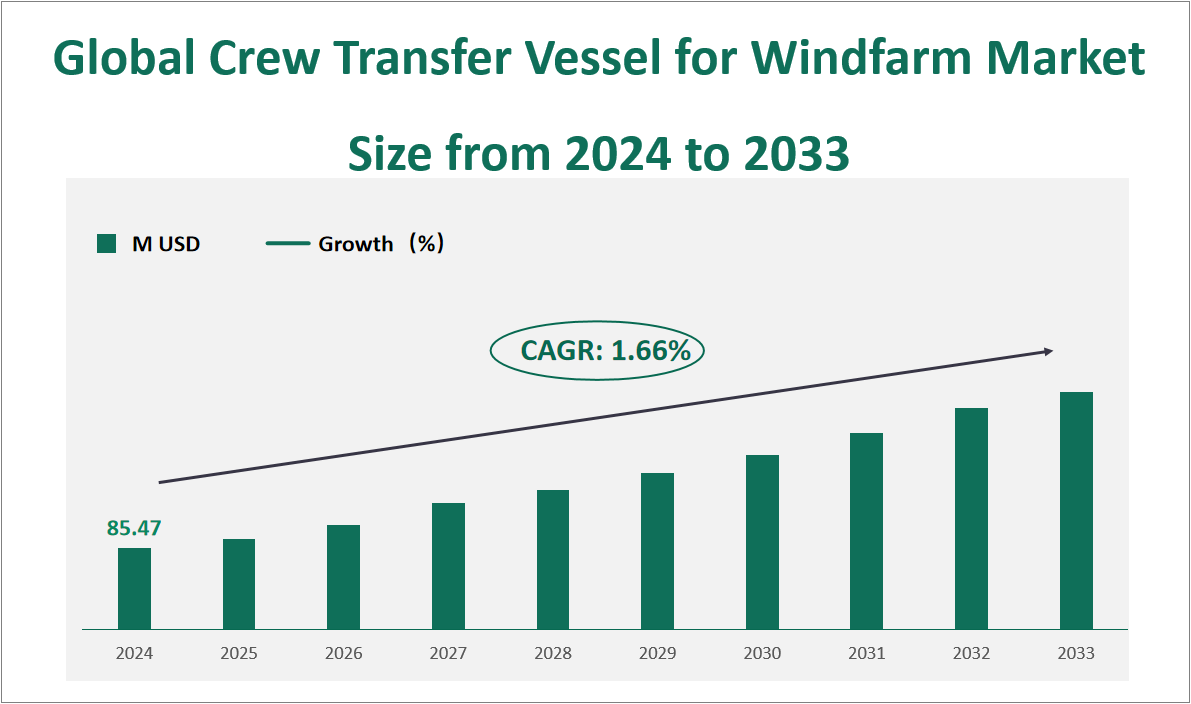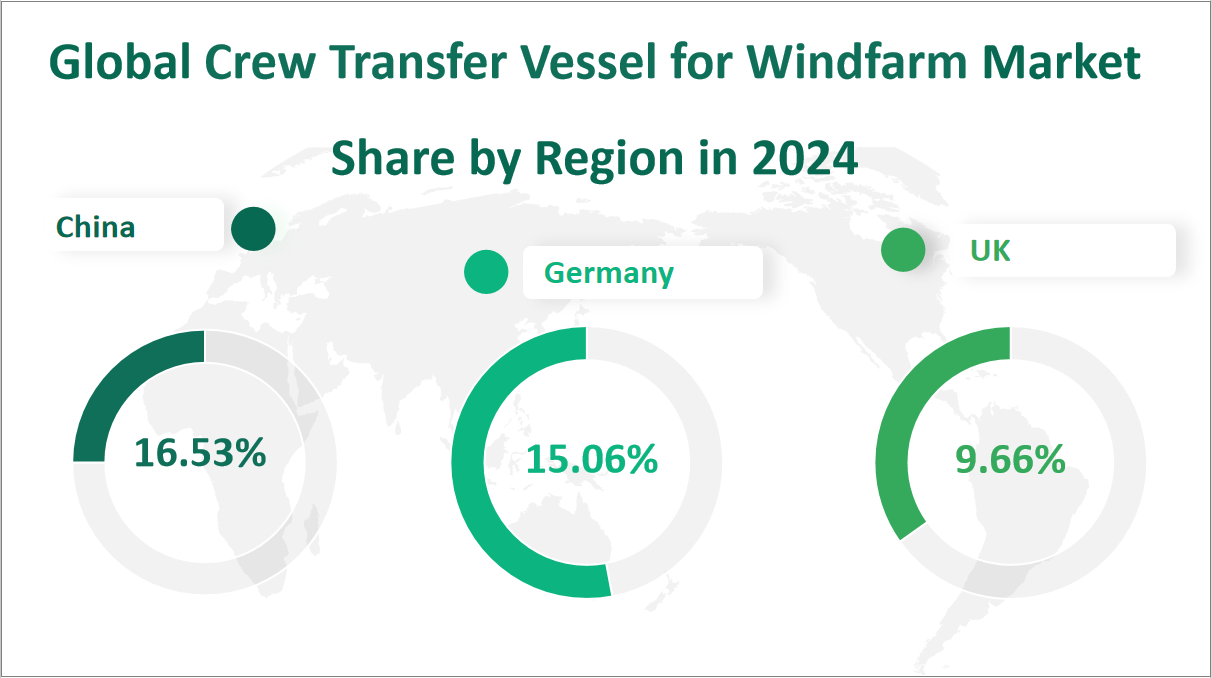1 Global Crew Transfer Vessel for Windfarm Market Outlook
The global Crew Transfer Vessel for Windfarm market is projected to exhibit substantial growth in the coming years, with a CAGR of 1.66% from 2024 to 2033, reaching a total market size of $85.47 million USD in 2024. Crew Transfer Vessels are specialized boats designed to transport personnel and equipment to and from offshore wind farms. These vessels play a crucial role in the construction, maintenance, and operation of wind turbines, ensuring that technicians and materials can reach remote sites efficiently and safely. The market for CTVs is highly specialized, with vessels ranging from monohulls to catamarans and trimarans, each tailored to specific operational requirements and sea conditions.
Figure Global Crew Transfer Vessel for Windfarm Market Size and Growth Rate (2024-2033)

2 Crew Transfer Vessel for Windfarm Market Growth Drivers and Constraints
The growth of the global Crew Transfer Vessel for Windfarm market is influenced by several key factors. On the positive side, the market is driven by the increasing demand for offshore wind energy, which is supported by government policies and initiatives aimed at promoting clean energy. For instance, countries like the UK, the Netherlands, and China have set ambitious targets for offshore wind capacity, driving the need for reliable transportation solutions. The UK government’s Energy Security Strategy aims to expand offshore wind capacity to up to 50 gigawatts by 2030, while the Netherlands plans to increase its offshore wind capacity to 21 gigawatts by 2030/2031. These policies are expected to significantly boost the market for CTVs.
However, the market also faces several challenges. High technical barriers and financial requirements are significant hurdles for new entrants. The construction of CTVs requires advanced engineering capabilities and substantial capital investment, making it difficult for small and medium-sized enterprises to compete. Additionally, the market is highly concentrated, with a few major players dominating the industry. Strategic Marine, Blount Boats, and Alicat are among the top companies, holding significant market shares in 2022. This concentration can limit competition and market entry.
3 Crew Transfer Vessel for Windfarm Market Innovations and M&A Activities
Technological innovation is a key driver in the Crew Transfer Vessel for Windfarm market. Companies are continuously improving vessel designs to enhance performance, safety, and efficiency. For example, advancements in hull design and propulsion systems have led to more stable and fuel-efficient vessels. Hybrid propulsion systems and hydrogen fuel technologies are also being explored to reduce carbon emissions, aligning with global sustainability goals.
Corporate activities, such as mergers and acquisitions, are also shaping the market. For instance, Strategic Marine completed the acquisition of a larger shipbuilding facility in Singapore in 2022, significantly boosting its production capacity and product range. This strategic move allows Strategic Marine to scale up its operations and offer larger vessels, enhancing its competitive position in the market.
In conclusion, the global market for Crew Transfer Vessels for wind farms is set for steady growth, driven by the expanding offshore wind energy sector and supported by government policies. While the market faces challenges such as high technical barriers and financial requirements, technological innovation and strategic corporate activities are key factors that will shape its future. As the demand for clean energy continues to grow, the market for CTVs is expected to play a crucial role in the development and maintenance of offshore wind farms.
4 Global Crew Transfer Vessel for Windfarm Market Analysis by Type
In 2024, the global market for Crew Transfer Vessels (CTVs) for wind farms is projected to generate a total revenue of $85.47 million. The revenue distribution by boat length is as follows: vessels below 25 meters are expected to contribute $15.30 million, accounting for 17.90% of the total market share; those between 25 and 27 meters are anticipated to generate $35.32 million, representing 41.32% of the market share; and vessels 27 meters or more are forecasted to produce $34.85 million, holding 40.78% of the market share. This segmentation highlights the diverse demand for CTVs of varying sizes, with mid-sized vessels (25-27 meters) continuing to dominate the market revenue in 2024.
Table Global Crew Transfer Vessel for Windfarm Market Size and Share by Type in 2024
Type | Market Size in 2024 (M USD) | Market Share in 2024 (%) |
|---|---|---|
Below 25m | 15.30 | 17.90% |
25m-27m | 35.32 | 41.32% |
27m or more | 34.85 | 40.78% |
5 Global Crew Transfer Vessel for Windfarm Market Analysis by Application
In 2024, the global market for Crew Transfer Vessels (CTVs) for wind farms is expected to see a total revenue of $85.47 million. By vessel type, monohulls are projected to generate a revenue of $8.89 million, accounting for 10.40% of the total market share. Catamarans are anticipated to contribute $50.33 million, representing 58.89% of the market share. Trimarans are forecasted to produce $34.85 million in revenue, holding 40.78% of the market share. This distribution indicates that catamarans will continue to dominate the market in terms of revenue, while monohulls and trimarans also play significant roles in the overall market value.
Table Global Crew Transfer Vessel for Windfarm Market Size and Share by Application in 2024
Application | Market Size in 2024 (M USD) | Market Share in 2024 (%) |
|---|---|---|
Monohull | 8.89 | 10.40% |
Catamaran | 50.33 | 58.89% |
Trimaran | 26.25 | 30.72% |
6 Global Crew Transfer Vessel for Windfarm Market Analysis by Region
In 2024, the global market for Crew Transfer Vessels (CTVs) for wind farms is projected to generate a total revenue of $85.47 million. Regionally, the UK is expected to contribute $8.26 million, accounting for 9.66% of the global market share. Germany is forecasted to produce $12.87 million in revenue, representing 15.06% of the market share. China is anticipated to generate $14.13 million, holding 16.53% of the market share. The Netherlands is expected to contribute $7.98 million, making up 9.34% of the global market share. These figures highlight the significant contributions from key regions, with China and the Netherlands emerging as major players in the global CTV market for wind farms.
Figure Global Crew Transfer Vessel for Windfarm Market Share by Region in 2024

7 Top 3 Companies of Global Crew Transfer Vessel for Windfarm Market
7.1 Strategic Marine
Company Introduction and Business Overview:
Strategic Marine is a leading shipbuilder with a global reputation for producing high-quality, high-performance commercial and government vessels. Established in 1998 and headquartered in Singapore, the company has a strong track record of delivering vessels for various maritime sectors, including offshore wind, tourism, and naval defense. Strategic Marine is known for its commitment to innovation and sustainability, often incorporating advanced technologies into its designs to enhance performance and reduce environmental impact.
Products Offered:
Strategic Marine offers a wide range of vessels, including monohulls, catamarans, and trimarans, designed to meet the specific needs of offshore wind farms. One of their key products is the 19.4-meter Crew Transfer Vessel, which features a robust design with a maximum deadweight of 18 tons and a cargo deck area of 35.5 square meters. This vessel is equipped with advanced propulsion systems and safety features, making it ideal for transporting personnel and equipment to offshore wind turbines.
Sales Revenue in the Latest Year:
Strategic Marine reported a revenue of $25.60 million from its Crew Transfer Vessel segment. This figure reflects the company’s strong market position and its ability to deliver high-quality vessels that meet the evolving needs of the offshore wind industry. Strategic Marine’s revenue growth is driven by its continuous innovation and expansion into new markets.
7.2 Blount Boats
Company Introduction and Business Overview:
Blount Boats is a renowned shipbuilder based in the United States, with a history dating back to 1949. The company specializes in designing and building commercial steel and aluminum vessels, including passenger ferries, fast commuter boats, and wind farm service vessels. Blount Boats is known for its commitment to quality and customer satisfaction, delivering vessels that are both reliable and efficient.
Products Offered:
Blount Boats offers a variety of vessels tailored for the offshore wind industry. One of their notable products is the first U.S.-flagged crew transfer vessel built for Atlantic Wind Transfers to service the Block Island Wind Farm. This vessel is designed to meet the specific needs of offshore wind operations, offering high-speed transportation and ample cargo capacity. Blount Boats’ vessels are equipped with advanced navigation and safety systems, ensuring safe and efficient operations in challenging maritime environments.
Sales Revenue in the Latest Year:
Blount Boats reported a revenue of $12.30 million from its Crew Transfer Vessel segment. This revenue highlights the company’s strong presence in the U.S. market and its ability to deliver high-quality vessels that meet the needs of offshore wind farm operators. Blount Boats’ revenue growth is driven by its reputation for reliability and innovation.
7.3 Alicat
Company Introduction and Business Overview:
Alicat is a specialist provider of custom marine and engineering services, headquartered in the UK. Established in 2009, Alicat has quickly gained a reputation for its expertise in building and maintaining high-quality vessels for various maritime sectors. The company’s services include boatbuilding, repair, refit, and design, with a focus on delivering customized solutions that meet the unique needs of each client.
Products Offered:
Alicat offers a diverse range of vessels, including crew transfer vessels, wind farm service vessels, and workboats. One of their key products is the trimaran crew transfer vessel, which features a sleek hull design and advanced propulsion systems. This vessel is designed to provide high-speed transportation and excellent stability in challenging sea conditions. Alicat’s vessels are equipped with state-of-the-art navigation and safety systems, ensuring safe and efficient operations.
Sales Revenue in the Latest Year:
Alicat reported a revenue of $10.45 million from its Crew Transfer Vessel segment. This revenue reflects the company’s strong market position and its ability to deliver high-quality vessels that meet the evolving needs of the offshore wind industry. Alicat’s revenue growth is driven by its commitment to innovation and customer satisfaction.

